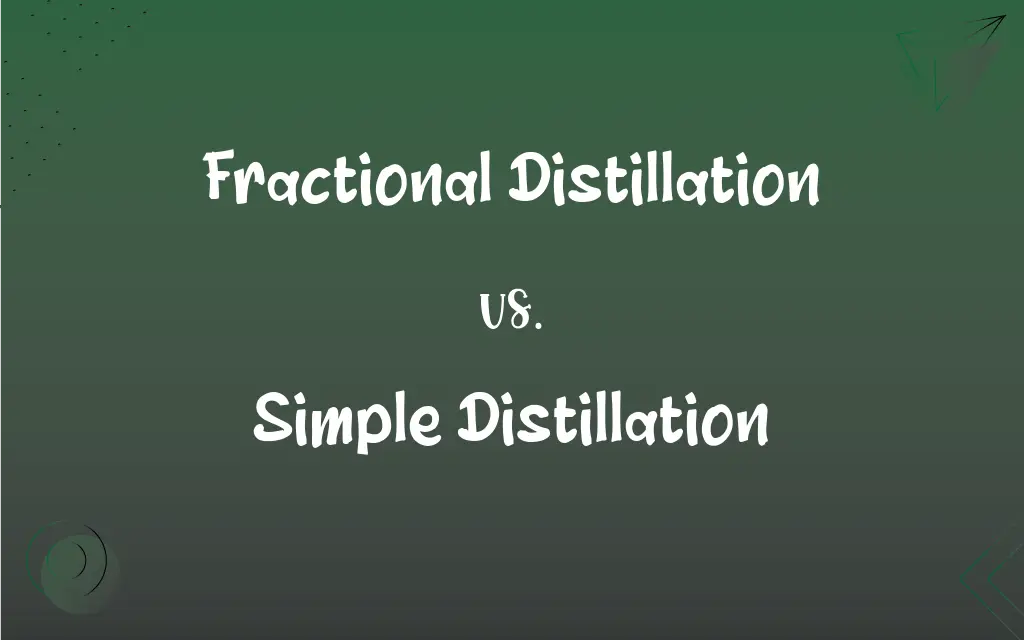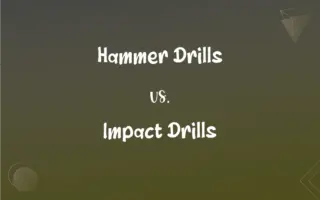Fractional Distillation vs. Simple Distillation: What's the Difference?
Edited by Aimie Carlson || By Harlon Moss || Updated on October 20, 2023
Fractional distillation separates mixtures into multiple components based on boiling points, while simple distillation separates a solvent from a solution in one step.

Key Differences
Fractional distillation and simple distillation are both separation techniques utilized in laboratories and industries. Fractional distillation is a method wherein a mixture is separated into its multiple components based on their different boiling points. This method often employs a fractionating column that allows for multiple vaporization-condensation cycles, enhancing separation.
Simple distillation, on the other hand, is a more straightforward process typically used to separate a solvent from a solution or two liquids with substantially different boiling points. In simple distillation, the mixture is heated, and the component with the lowest boiling point evaporates first, condensing and being collected separately.
One of the key differences between fractional distillation and simple distillation lies in the precision of separation. Fractional distillation can differentiate between substances with very close boiling points, thanks to the fractionating column. This makes it ideal for separating complex mixtures, such as petroleum into various fractions.
Simple distillation lacks this precision, making it less suitable for separating components with close boiling points. Instead, it's more commonly used for purifying a single component, like obtaining distilled water from tap water. While both methods exploit the principle of varying boiling points, their applications and intricacies differ significantly.
The equipment used for each process also distinguishes them. Fractional distillation requires a fractionating column, which provides surface area for repeated vaporization and condensation, whereas simple distillation employs a simpler setup without this column.
ADVERTISEMENT
Comparison Chart
Definition
Separates mixtures into multiple components based on boiling points.
Separates a solvent from a solution or liquids with different boiling points.
Precision
Can separate components with close boiling points.
Best for liquids with significantly different boiling points.
Equipment
Uses a fractionating column.
Does not require a fractionating column.
Applications
Ideal for complex mixtures like petroleum.
Commonly used for purifying single components.
Vaporization-Condensation
Multiple cycles due to the fractionating column.
One cycle, with the component of the lowest boiling point evaporating first.
ADVERTISEMENT
Fractional Distillation and Simple Distillation Definitions
Fractional Distillation
Distillation exploiting boiling point differences in a detailed manner.
Fractional distillation is employed in labs for accurate separation tasks.
Simple Distillation
A technique separating a solvent from a solution.
Simple distillation is used to obtain distilled water from saline water.
Fractional Distillation
Technique distinguishing substances with close boiling points.
Fractional distillation allows for separation of alcohols of different chain lengths.
Simple Distillation
A method best for liquids with substantially different boiling points.
Using simple distillation, ethanol can be separated from a water-ethanol mixture.
Fractional Distillation
An advanced distillation process providing repeated vaporization-condensation cycles.
The precision of fractional distillation makes it suitable for complex mixtures.
Simple Distillation
A basic distillation process without repeated vaporization-condensation cycles.
Simple distillation quickly separates solvents from impurities.
Fractional Distillation
A method employing a fractionating column for separation.
Through fractional distillation, many fractions of petroleum are obtained.
Simple Distillation
Separation based on one vaporization-condensation cycle.
In simple distillation, the substance with the lowest boiling point evaporates first.
Fractional Distillation
A process separating mixtures into their components based on boiling points.
Fractional distillation of crude oil produces various products like gasoline and diesel.
Simple Distillation
A straightforward method without a fractionating column.
For separating two liquids with a wide boiling point difference, simple distillation is sufficient.
FAQs
Does fractional distillation require special equipment?
Yes, it typically uses a fractionating column for precise separation.
Can simple distillation separate components with close boiling points effectively?
No, it's best for components with significantly different boiling points.
Is simple distillation complex?
No, it's a straightforward process without repeated vaporization-condensation cycles.
Can I obtain pure water from saltwater using simple distillation?
Yes, simple distillation can separate water from salt, producing distilled water.
When should simple distillation be used?
Simple distillation is best when separating a solvent from a solution or liquids with different boiling points.
Is simple distillation faster than fractional distillation?
Generally, simple distillation is quicker due to its single vaporization-condensation cycle.
How do industries benefit from fractional distillation?
Industries can produce multiple refined products from raw mixtures using fractional distillation.
What's the primary factor in choosing between the two distillation methods?
The boiling point differences of the components determine the choice.
What's the main purpose of fractional distillation?
Fractional distillation separates mixtures into multiple components based on their boiling points.
Which distillation method is used for petroleum refining?
Fractional distillation is used for refining petroleum into various fractions.
What are the common products from fractional distillation of crude oil?
Products include gasoline, diesel, kerosene, and many others.
What provides the precision in fractional distillation?
The fractionating column allows for repeated vaporization and condensation, offering precision.
Are there mixtures too complex for simple distillation?
Yes, mixtures with components having close boiling points need fractional distillation.
How does the fractionating column work in fractional distillation?
It provides surface area for repeated vaporization and condensation, enhancing separation.
Can both distillation methods be used in labs?
Yes, both methods are used in labs depending on the separation requirements.
Why can't simple distillation produce multiple fractions?
It undergoes one vaporization-condensation cycle, limiting its separation capability.
Can I use simple distillation for alcoholic beverages?
Yes, it can separate alcohol from water, but for better separation, fractional distillation is more effective.
Which method is more energy-intensive?
Fractional distillation generally requires more energy due to repeated vaporization-condensation cycles.
Why is fractional distillation more accurate?
It employs a fractionating column, allowing for enhanced separation of close-boiling components.
Is the equipment for simple distillation simpler?
Yes, simple distillation requires less complex equipment without a fractionating column.
About Author
Written by
Harlon MossHarlon is a seasoned quality moderator and accomplished content writer for Difference Wiki. An alumnus of the prestigious University of California, he earned his degree in Computer Science. Leveraging his academic background, Harlon brings a meticulous and informed perspective to his work, ensuring content accuracy and excellence.
Edited by
Aimie CarlsonAimie Carlson, holding a master's degree in English literature, is a fervent English language enthusiast. She lends her writing talents to Difference Wiki, a prominent website that specializes in comparisons, offering readers insightful analyses that both captivate and inform.































































